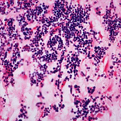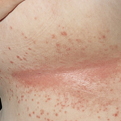Candidiasis
General Information
Candidiasis, commonly called yeast infection, is a fungal infection (mycosis) of any of the Candida species. Candida albicans is the most common of the Candida species. The range of infection ranges superficial to systemic and potentially life threatening disease. A severe disease is usually confined to severely immunocompromised individuals such as AIDS patients. Lymphocytes and cell-mediated immunity are important factors in preventing mucosal candidiasis. Therefore, patients that have any T-cell deficiency have a tendency to develop recurrent and/or persistent mucocutaneous candidiasis. Candida is a group of about 150 yeast species. C. albicans is responsible for about 70 to 80% of all candidal infections. Other significant species include C. glabrata, C. tropicalis, C. krusei, and C. dubliniensis. Most infections can be treated at home with over the counter medication or prescription medication, which include topical administration of antifungal such as clotrimazole, miconazole, nystatin, tioconazole, or oral administration of drugs such as fluconazole and amphotericin B. If the infection is more serious, IV medications may need to be given at hospitals.
Epidemiology
Occurs in equal numbers of males and females; however, in women, this the second most common cause of vaginitis
Etiology
Dampness, heat, and impaired local and systemic defenses provide a fertile environment for it to grow
Pathogenesis
Unicellular yeast whose cells reproduce by budding
Clinical
Wide range of clinical manifestations from self-limited local mucocutaneous disease to severe sepsis with multiorgan system failure
Histology
Presence of neutrophils in the stratum corneum
Bibliography
1.”Candidiasis” (Online) December 2007. http://www.emedicine.com/emerg/topic76.htm (visited: March 14, 2008) 2. “Candia Albicans” (Online). http://www.healthscout.com/ency/68/312/main.html (visited: March 14, 2008)
Download PDF
![]() Candidiasis
Candidiasis


